If you’re planning a picnic, a barbeque, or an outdoor celebration (like a wedding, fundraiser, or corporate event), you’re almost certainly going to need some plates, cups, utensils, and other tableware necessities!
You’ll most likely want to go for something that’s lightweight and unbreakable. Additionally, depending on the nature of your event and the crowd size, you may need disposable dinnerware, or you may go for reusable tableware for a more low-waste option. (We’ve included recommended brands for both below!)
Typical outdoor plates, cups, and cutlery contain toxins like phthalates and PFAS. Read on to learn more about the toxic chemicals in outdoor dinnerware and then get our recommended brands that you can feel good about eating off of.
Related Articles:
Table of Contents
- Toxins In Paper Plates & Other Outdoor Dinnerware
- BPA, Phthalates, & Other Endocrine Disruptors
- PVC
- Melamine
- PFAS (“Forever Chemicals”)
- Polystyrene (a.k.a Styrofoam)
- Best Non-Toxic Disposable Dinnerware
- Best Non-Toxic Reusable Dinnerware
- Other Accessories for Your Non-Toxic Picnic or Outdoor Gathering
- FAQs About Disposable Tableware
This article may contain affiliate links, which means we may earn a commission if you decide to make a purchase. We only make recommendations that are genuine and meet our standards.
Featured Image Credit: Repurpose
Toxins In Paper Plates & Other Outdoor Dinnerware
A lot of people use plastic for their outdoor dinnerware because it’s lightweight and unlikely to break if dropped. However, plastic often comes with toxic chemicals. Here are the most common ones:
BPA, Phthalates, & Other Endocrine Disruptors
A lot of plastic tableware (both reusable and disposable) contain things like BPA, BPS, and phthalates.
These chemicals are endocrine disruptors, which means they can mess with hormones and cause things like infertility, early puberty, breast cancer, and more.
PVC
One of the most toxic kinds of plastic, PVC contains chlorine, which creates toxic byproducts called dioxins and furans. According to the World Health Organization (WHO), dioxins “can cause reproductive and developmental problems, damage the immune system, interfere with hormones and also cause cancer.”
PVC can also be a source of phthalates.
Melamine
Melamine is really popular for non-breakable plates and other dinnerware, but it’s just another kind of plastic… and it’s NOT non-toxic.
A number of studies have found that melamine can leach into foods and beverages, especially with acidic foods or beverages, fatty or oily foods, and high temperatures.
You can read more in our deep dive into melamine dishes right here.
Home
Is Melamine Safe? (And Alternatives for Melamine Dishes)
The melamine safety record isn’t stellar, so why risk your or your family’s health? Fortunately, there are several melamine tableware alternatives to choose from.
It should also be noted that most reusable bamboo dinnerware (like Ekobo and Bamboozle, for example) also contain melamine, usually somewhere around 15%.
The melamine keeps the bamboo sturdy and prevents it from breaking down for a more durable and long-lasting product. Even though it may be an imperfect option, it’s still a better option than 100% plastic or melamine dishes. It’s just something you may want to be aware of when shopping for non-breakable reusable tableware. You have to make the best decision for you!

PFAS (“Forever Chemicals”)
So, paper plates should be better than plastic, right? After all, they’re made from natural resources and don’t have all of those chemicals that so often come along with plastic…
Well, not exactly.
The main problem with paper plates (and a lot of other types of disposable food products and packaging, for that matter) is that so many of them have toxic PFAS added to them in order to increase resistance to water and grease.
PFAS are an extremely toxic group of chemicals that are linked to things like heart disease, cancer, birth defects, and more. They also don’t break down, which means once they’re in our bodies and environments, they stay there.
Recent state legislation is beginning to turn the tide on PFAS in food packaging and other consumer products, but the problem hasn’t been solved yet, so you’ll still want to watch out for PFAS in things like paper plates for now.
Polystyrene (a.k.a Styrofoam)
There’s a good chance you already know by now that styrofoam isn’t good for you or for the planet; it’s become pretty notorious over the past decade.
Styrofoam is just another type of plastic and it is a suspected carcinogen. (It also doesn’t biodegrade and is generally just bad for our ecosystems.)
Home
Best Non-Toxic Paper Towels (Bamboo, Reusable, Unbleached, & More)
A look at the common toxins found in conventional paper towels, the best bamboo and unbleached paper towel brands, and other great alternatives.
Okay so that you know what to watch out for, let’s get to our favorite non-toxic outdoor dinnerware brands:
Best Non-Toxic Disposable Dinnerware
If you’re looking for tableware for a larger event like a wedding, corporate gathering, or another special large group event, here are our recommended brands for disposable plates, cups, and cutlery:
Repurpose (Plant-Based)

To make large-scale picnics and outdoor gatherings easier, Repurpose carries a variety of non-toxic disposable plates, cups, bowls, straws, and cutlery.
Their plant-based tableware is made out of things like upcycled sugarcane and recycled wood chips. They’re free of harmful chemicals like BPA and PFAS but don’t sacrifice on sturdiness or durability.
Even though their products are meant to be single-use, you can technically wash them a few times before (especially the cups and cutlery; not so much with the plates and bowls).
In addition to their non-toxic disposable tableware, Repurpose also carries other products like paper towels, toilet paper, trash bags, and more. You can also sign up for a convenient subscription, which will save you 10%.
Repurpose’s products are commercially compostable, which means you’d have to send them to a commercial composting facility after you use them. This is the case for most of the “compostable” and bio-based cups and plates you see on the market these days.
Obviously, this is not ideal since the reality is that most of these products aren’t really going to make it to commercial facilities. We really hope to see more home-compostable products come to the market in the near future… But in the meantime, this is definitely a much better option than conventional plastic and styrofoam disposables, which will basically never biodegrade!
Use code THEFILTERY15 for 15% off.
Bambu (Bamboo)

Bambu carries both disposable and reusable dinnerware which includes plates, utensils, serving trays, napkins, and more.
They use USDA and/or LETIS certified organic bamboo and are completely free from things like pesticides, bleaches, dyes, glues, or laquers.
Their reusable products are finished with a natural, food-grade, and certified flaxseed oil.
Bambu’s disposable dinnerware is compostable and the company states that it can even biodegrade in a landfill in 4-6 months (impressive!). This Veneerware® line can be composted either at home or in an industrial compost facility. They said the length of time it takes to compost can vary, but you can shorten the time by cutting the plates and cutlery into smaller pieces if you want to.
Eco Soul (Palm Leaves)
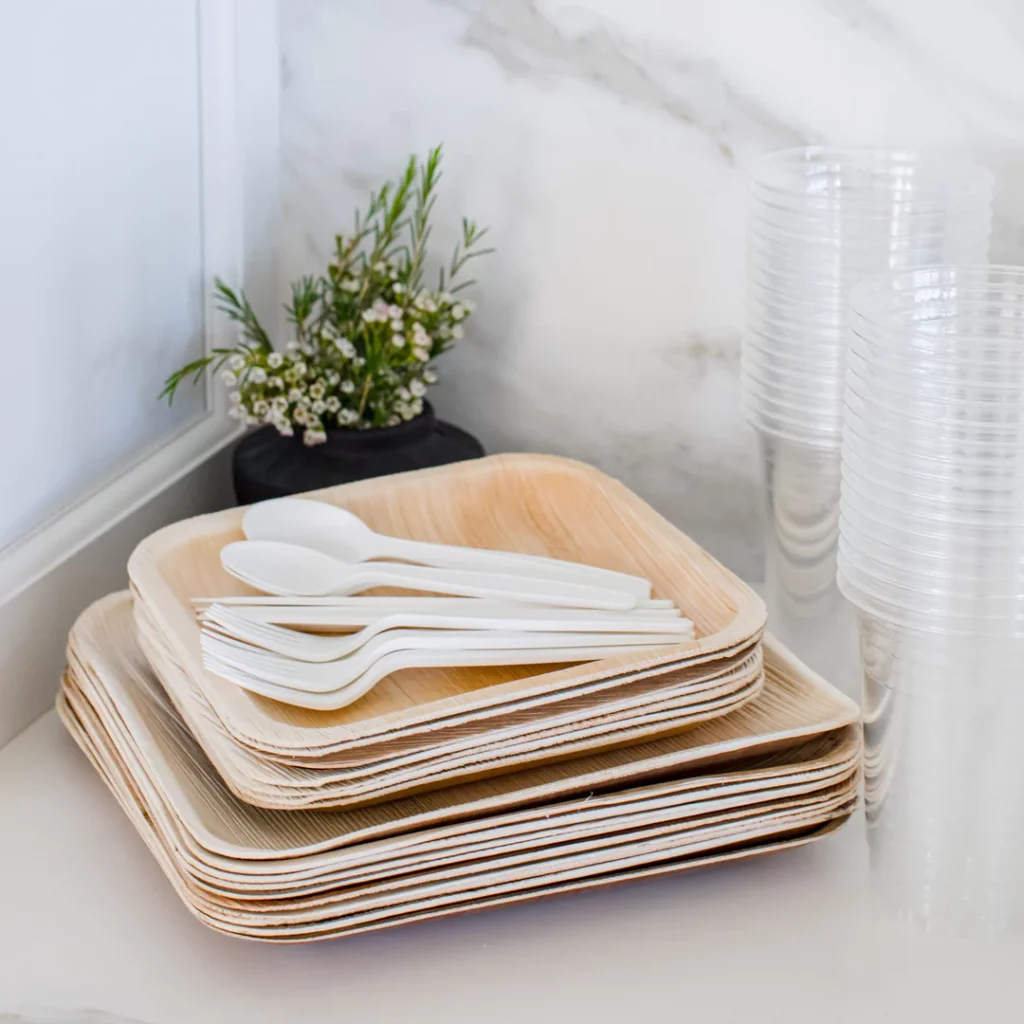

Palm leaf plates, bowls, and cutlery is very similar to bamboo. Palm leaves are a plant-based, plastic-free, timber-free way to make a disposable and compostable product. Eco Soul says they use fallen palm leaves, which is thought to be even better for the environment because they’re no actually shopping anything off of trees.
In addition to palm leaves, they also use sugarcane fiber, bamboo, and corn starch for their collection of disposable tableware. They’re all free from things like PFAS and BPA.
All of their products are said to be compostable, but some are at-home compostable while others will need to be sent to an industrial composting facility.
Best Non-Toxic Reusable Dinnerware
If you’re looking for non-toxic dinnerware for everyday use, here are our favorite brands for durable, shatter-resistant, and non-toxic reusable plates, cups, and more.
Ahimsa (Stainless Steel)
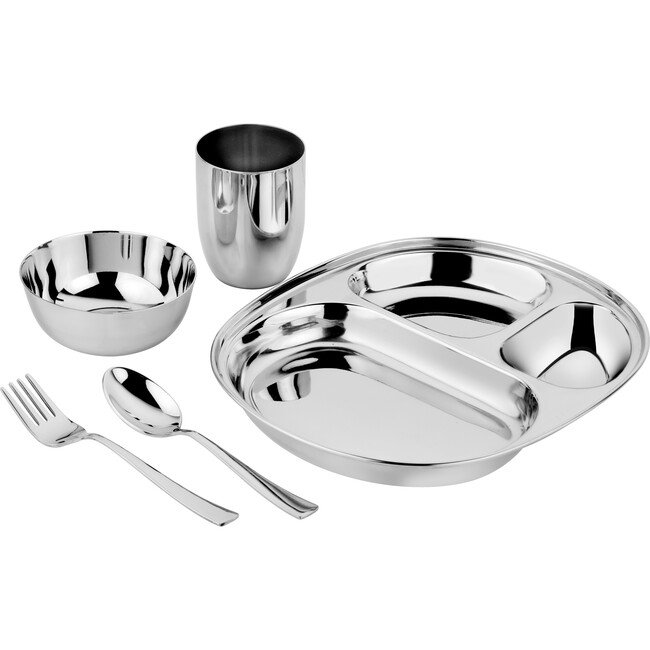

Although these dinnerware sets are designed and manufactured with little ones in mind, they can actually be used by people of any age.
Ahimsa’s stainless steel dinnerware was designed by pediatrician moms in response to the American Academy of Pediatrics warning about the danger of plastic for kids. They’re completely free from BPA, phthalates, PVC, melamine, and lead. They’re now MADE SAFE certified as well, which is one of our favorite third party certifications for ingredient and material safety.
These plates, utensils, and cups are available in “Classic” stainless steel, “Rainbow,” and “Iridescent Blue.” They’re dishwasher safe, but hand-wash recommended.
ECOLunchbox and Klean Kanteen also have some good options for stainless steel plates and to-go containers for things like meal-prep and camping.
ezpz (Silicone)
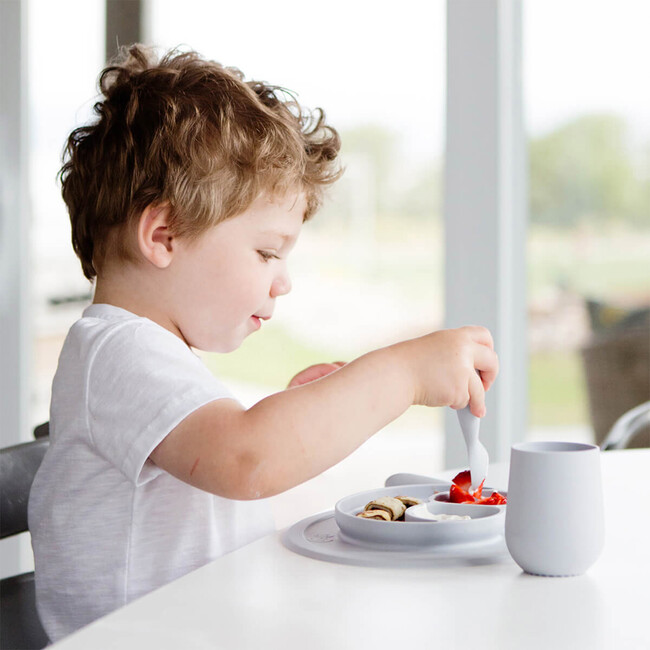
Lots of parents love silicone dinnerware for everyday use, whether inside or outside. It’s a really durable and shatter-proof alternative to plastic (and it won’t make a big noise when dropped like stainless steel will!).
ezpz is a parent-favorite brand that makes plates, mats, cups, and utensils for littles that are free from BPA, phthalates, PVC, and lead.
When shopping for silicone tableware, make sure you’re getting 100% silicone because some products can contain fillers that may not be as safe. Additionally, there is some concern that silicone may leach endocrine disruptors at high temperatures. For that reason, we recommend not cooking or baking with silicone.
Almost all of ezpz’s products are made with 100% food-grade silicone that is 3rd-party quality tested and approved by the FDA and CPSC. The only exception to this is their Mini and Happy Utensils, which have about 10% nylon (this is to make for a studier utensil to help little ones learn how to feed themselves more easily).
Holland Bowl Mill (Wood)
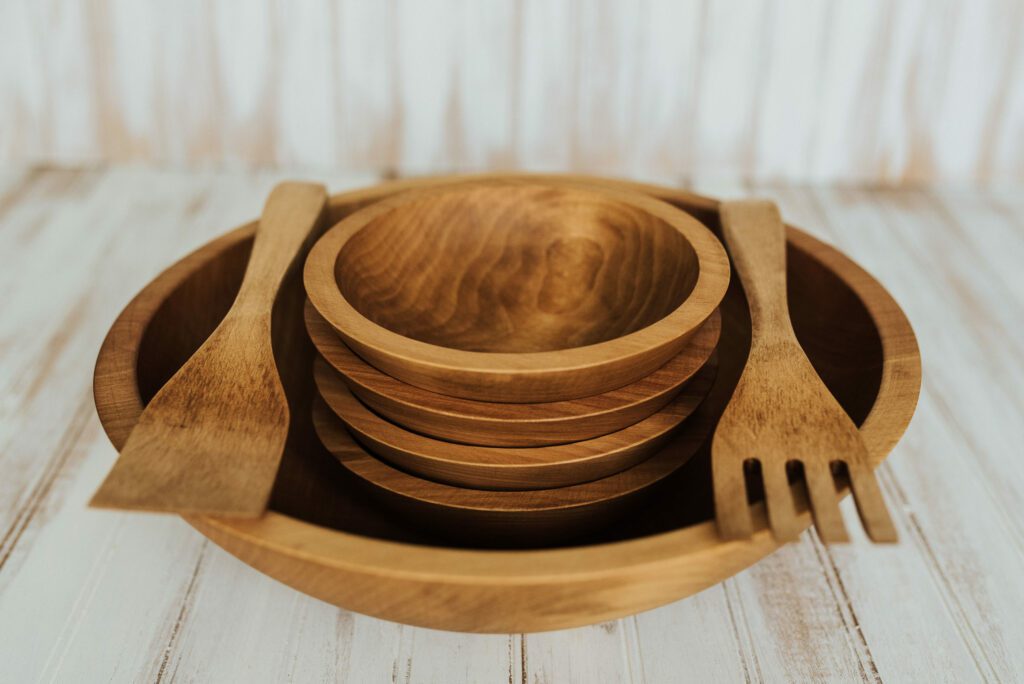
Wood is another great natural, plastic-free option for plates and bowls. It’s relatively lightweight and is resistant to breaking if it’s dropped. Plus, they look really beautiful and can easily be used for indoor dining as well.
Holland Bowl Mill is based in Michigan where they hand-make their bowls, plates, and other accessories. In fact, they say they’re using the same method that’s been used for over one hundred years, and it takes nearly a month to complete the entire process. They use a variety of American hardwoods including Beech, Cherry, Walnut, Red Oak and Hard Maple. They use a non-toxic and food-safe finish that’s made out of bee oil and other natural oils.
Liewood (Silicone)
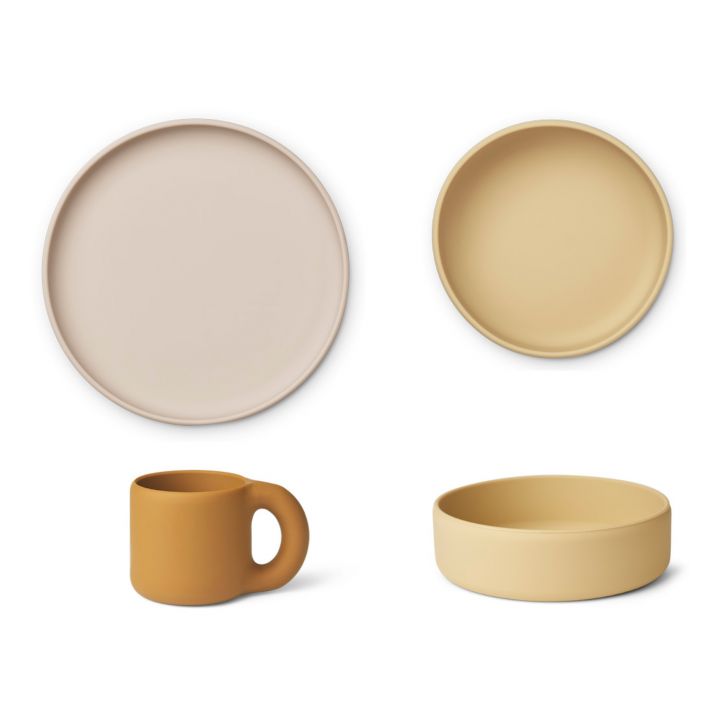
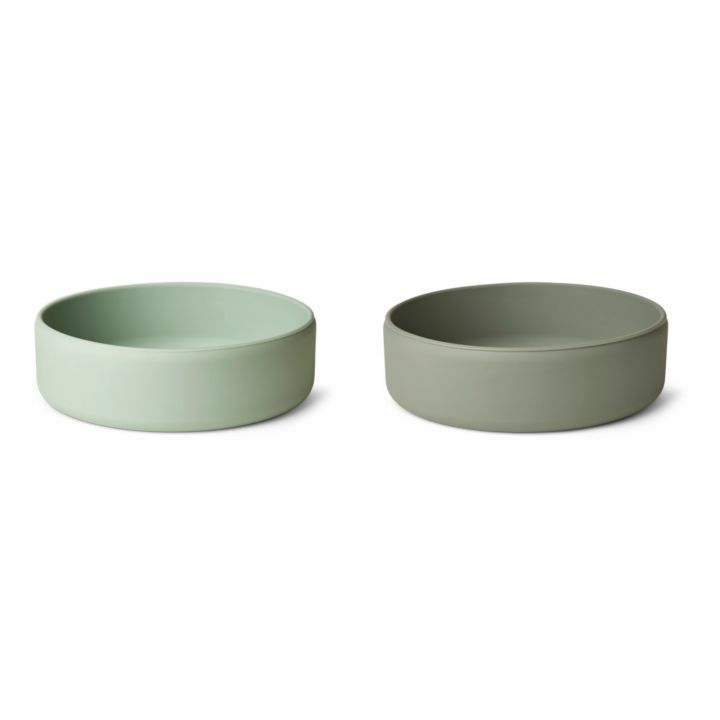
Even though Liewood’s products are also technically made with kids in mind, their collection of silicone dishes will honestly work for the whole family!
In addition to their unbreakable and 100% silicone plates, cups, and bowls pictured above, they also carry a variety of other silicone dishware, including super cute bear-shaped ones, snack boxes, and more.
As a Danish brand rooted in the Nordic design tradition, this environmentally-conscious and ethically-minded brand embraces pure shapes, delicate prints, and muted colors.
Additionally, a couple of other good silicone dinnerware brands to check out are Baby Bar & Co., Avanchy, and Lalo. (You can check out our full review of Lalo’s high chair and dinnerware set right here!)
Other Accessories for Your Non-Toxic Picnic or Outdoor Gathering

Here are some more picnic necessities from some of our favorite non-toxic, organic, and eco-friendly brands:
- For organic picnic blankets: Coyuchi
- For organic wine bottle totes and dish carriers: Aplat
- For artisan-made picnic baskets: KAZI
- For grills, camp stoves, fire pits, and more: Solostove
FAQs About Disposable Tableware
Are Paper Plates Safe to Eat Off Of?
Most paper plates contain toxic PFAS, a.k.a “forever chemicals,” which are added to increase resistance to oils and liquids. Considering that this family of chemicals is linked to a variety of serious health concerns (including cancer, heart disease, birth defects, and more) AND they can never break down, the majority of paper plates are actually not truly safe to eat off of.
What Are the Safest Paper Plates?
Since they are plant-based, plastic-free, and completely free from toxic PFAS, we recommend Repurpose as the safest paper plates for you and your family.
Is It Bad to Microwave Paper Plates?
Most toxins (PFAS, phthalates, etc.) become a lot more dangerous when exposed to heat. This is because most of them are more likely to leach into your food, beverage, or the air at higher temperatures. Because of this, it’s not usually a good idea to microwave paper plates. There are a few exceptions to this, like Repurpose’s paper plates, which are both non-toxic and microwave safe.
Although disposable plastic and paper plates, cups, and utensils are convenient in that they are lightweight and durable, they often come with toxic chemicals. That’s why many people are thinking twice about which types of materials they’re eating off of. We hope this guide has been helpful in planning your next outdoor gathering!
To get more guides, tips, and more delivered to your inbox once a week, be sure to sign up for Filtered Fridays.






